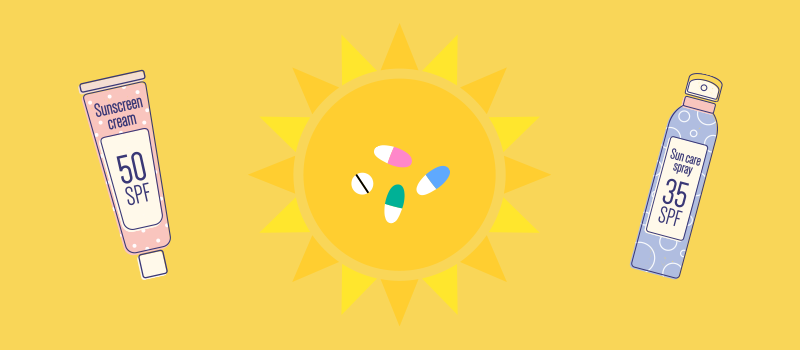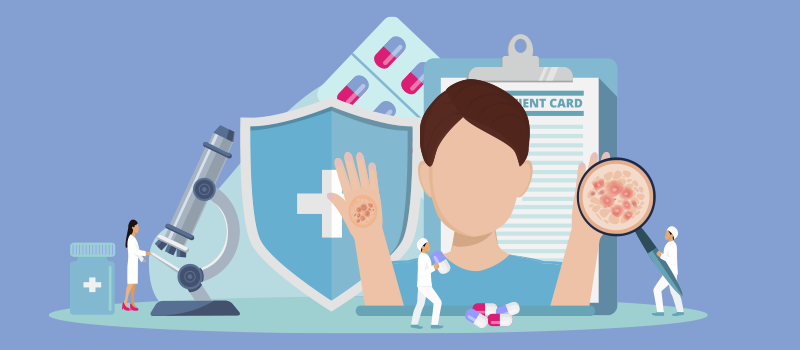What’s the Buzz
The Bee Healthy Blog
Demodex Folliculorum: Mites on Your Face?

Bacteria, fungi, and viruses all live within the human body; some are harmful, while others can actually be beneficial for your health. In particular, Demodex folliculorum, also known as face mites, is a type of parasite that lives on the human skin surface. These microscopic mites usually live on the face, including eyelids and eyelashes, and feed on built-up dead skin cells, oils, and hormones[1]. Although it sounds quite abnormal, this condition is quite common in young adults, with new research showing that every adult over 18 has these mites on their face or hair follicles[2]. Here’s, everything you should know about the skin condition Demodex folliculorum.
What is Demodex folliculorum?
There are two species of Demodex found in humans—Demodex folliculorum and Demodex Brevis. Demodex folliculorum live in hair follicles, primarily on the face, as well as in the meibomian glands (which line the margin of the eyelids), while Demodex brevis are mites that live in the sebaceous glands of the skin (glands usually attached to a hair follicle). Both are minuscule at about 0.2 mm-0.4 mm in length and cannot be seen with the naked eye[1].
Demodex mites may serve a useful purpose by feeding off dead skin cells to help rid the face of waste. Dead human skin cells are the largest component of household dust and, just like dust mites, Demodex folliculorum may be part of a natural cleaning system[2].
What are the symptoms of Demodex mites?
Demodex folliculorum symptoms can often be mistaken for other inflammatory dermatoses, such as folliculitis, rosacea, and perioral dermatitis. Common symptoms include:
- Redness
- Acne-like blemishes
- Increased skin sensitivity
- Burning sensation
- Rough skin
- Eczema
What causes Demodex folliculorum?
Although these mites are common and usually harmless, they can cause problems for people with weakened immune systems and other health/skin conditions. Controlling the mites may help the outcome of these types of inflammatory conditions.
You may be at an increased risk of getting Demodex mites if you suffer from:
- Weakened immune system
- HIV
- Skin infections
- Acne
- Rosacea: A common skin condition that can cause facial redness, bumps, eye problems, and an enlarged nose. These signs and symptoms may flare up for weeks to months and then go away for a while. Rosacea can affect anyone and there’s no cure, but with proper treatment, you can lessen the symptoms[3]. Studies indicate that patients with rosacea have 15 to 18 times more face mites[4].
- Alopecia: A condition that causes hair to fall out in small patches. This condition develops when the immune system attacks the hair follicles, resulting in hair loss[5].
- Dermatitis: A term to describe skin irritation such as itchiness, dryness, or redness. It can occur in many conditions such as atopic dermatitis (eczema), dandruff, and contact dermatitis[6].
People who have a Demodex infestation on their faces may be diagnosed with demodicosis. Symptoms of demodicosis include:
- Scales around the hair follicles
- Red skin
- Sensitive skin
- Itchy skin
How are Demodex mites treated?
With a life cycle of about two weeks, Demodex are pretty easy to treat yourself with a few at-home remedies. However, it’s always a good idea to seek medical advice since these mites can only be seen under a microscope. Your dermatologist may recommend treatment with topical insecticide creams such as crotamiton, ivermectin 1%, or permethrin that can kill Demodex mites and reduce their numbers. You may also be prescribed antibiotics such as topical or oral metronidazole. If you decide to treat the folliculorum mite at home, here are a few skincare routine tips:
- Cleanse your face twice daily (once in the morning and once before you go to bed).
- Clean eyes thoroughly (hair follicle mites can congregate on the eyelash region and can begin to cause eyelash conditions like hair loss, inflammation, or clumpy eyelashes).
- Use Salicylic acid: Dissolves oils, which is helpful in getting rid of Demodex mites. (There are OTC as well as prescription medications based on what your doctor recommends).
- Add sulfur into your skincare routine: You can purchase sulfur soaps and creams, which are naturally antifungal and antibacterial.
- Pure tea tree oil: Tea tree is known to have antifungal and anti-inflammatory properties that can kill existing mites and control the spread.
- Change your pillowcase often: To help keep the mites under control, it’s recommended you change your pillowcase at least once a week and ideally every 3 days.
Although common and in most cases harmless, the overgrowth of folliculorum mites can cause inflammation and rosacea-like symptoms. Make sure to visit your dermatologist for a proper diagnosis, and if you do need help affording skincare medications, the BuzzRx card can help you save.
[1]https://www.ncbi.nlm.nih.gov/pmc/articles/PMC3884930/#:~:text=Demodex%2C%20a%20genus%20of%20tiny,varying%20between%2023%2D100%25.
[2] https://www.rosacea.org/patients/the-ecology-of-your-face-demodex-rosacea-and-yo
[3] https://www.mayoclinic.org/diseases-conditions/rosacea/symptoms-causes/syc-20353815
[4] https://www.healthline.com/health/demodex-folliculorum
[5] https://www.healthline.com/health/alopecia-areata#:~:text=Alopecia%20areata%20is%20a%20condition,follicles%2C%20resulting%20in%20hair%20loss.
[6] https://www.mayoclinic.org/diseases-conditions/dermatitis-eczema/symptoms-causes/syc-20352380











SOCIAL